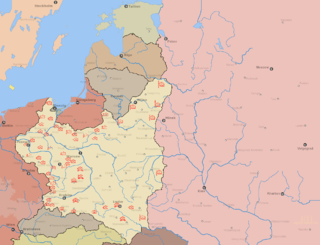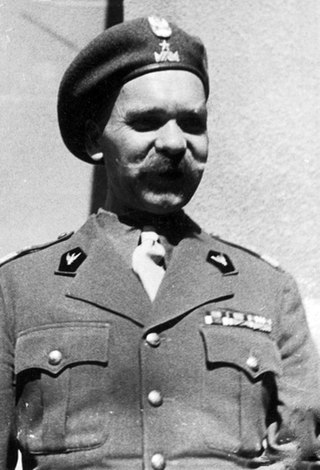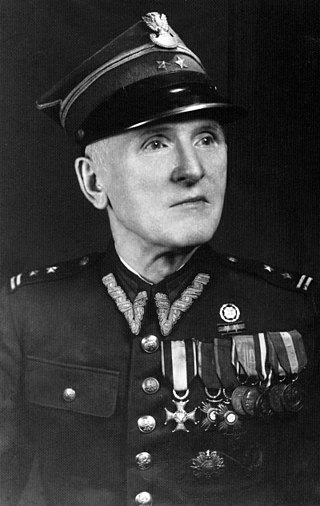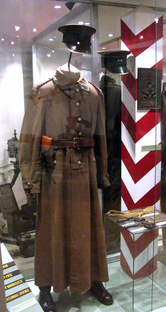
Operation Tempest was a series of uprisings conducted during World War II against occupying German forces by the Polish Home Army, the dominant force in the Polish resistance.

The Battle of Kock was the final battle in the invasion of Poland at the beginning of World War II in Europe. It took place between 2–5 October 1939, near the town of Kock, in Poland.

This article discusses the Polish order of battle during the invasion of Poland. In the late 1930s Polish headquarters prepared "Plan Zachód", a plan of mobilization of Polish Army in case of war with Germany. Earlier, the Poles did not regard the Germans as their main threat, priority was given to threat from the Soviets.
Independent Operational Group Polesie was one of the Polish Army Corps that defended Poland during the Invasion of Poland in 1939. It was created on 11 September 1939 and was commanded by general Franciszek Kleeberg. The SGO is most notable for fighting in the battle of Kock, the last battle of the Invasion of Poland.
Battle of Szack (Shatsk) was one of the battles between the Polish Army and the Red Army fought in 1939 in the beginning of the Second World War.

Polish 1st Legions Infantry Division is a tactical unit of the Polish Army. Formed on February 20, 1919, partially of veterans of the I Brigade of the Polish Legions, the unit saw extensive action during the Polish-Bolshevik War and World War II. Regarded by the soldiers of the Wehrmacht as the Iron Division, it distinguished itself in the Invasion of Poland.

The Battle of Wilno was fought by the Polish Army against the Soviet invasion of Poland in 1939, which accompanied the German Invasion of Poland in accordance with Molotov–Ribbentrop Pact. On 18–19 September, Soviet forces took over the city of Wilno. Polish forces, concentrated in the west, were relatively weak in the east. The Polish commanders, unsure whether to actively oppose the Soviet entry into Poland, did not use the full defensive capabilities of the town and nearby fortifications, although the outcome of the battle would not have been likely any different, given the overwhelming Soviet numerical superiority.
Plan East was a Polish defensive military plan that was created in the 1920s and the 1930s in case of war against the Soviet Union. Unlike Plan West, it was being prepared during the whole interwar period, as the government of the Second Polish Republic treated the Soviet Union as the greatest potential military threat that was capable of initiating a full-scale war. However, only a few loose historical documents remain of the original plan today.
The 1st Mountain Brigade was a unit of the Polish Army during the interbellum period, which took part in the Polish September Campaign. Commanded by Colonel Janusz Galadyk, it was part of the Bielsko Operational Group of the Army Kraków. It consisted mostly of units of the Border Defence Corps (KOP), sent to southwestern Poland from the Eastern Borderlands. Created on July 7, 1939, its task was to defend the southern wing of the Army, in the section between Żywiec and Rabka.
Sarny Fortified Area was a line of bunkers and trenches along both sides of the Sluch River, in the area of the town of Sarny, northern Volhynia, in Ukraine. During the interbellum period, Sarny belonged to the Second Polish Republic and was near the border with the Soviet Union. As the Polish military authorities regarded the Soviets as the main threat, construction of fortifications began in 1936. It was planned to be fully operational in the spring of 1940. The total length of the defence works was some 170 km, with 358 objects.
Border Defense Corps Regiment Sarny was a unit of the Second Polish Republic's Border Defence Corps, stationed in Sarny, Wołyń Voivodeship, near pre-1939 Polish – Soviet border.

A Dowództwo Okręgu Korpusu was a military district of the Ministry of Military Affairs of the Second Polish Republic. It served as an organizational, mobilisational, and administrative body of the Polish Army and all local military units of the country were subject to the Corps commands. Also, the DOKs ran all Military Draft Offices of Poland. The system of DOKs was modeled after the French Army, and according to Polish planners, each district located along either Soviet or German border was supposed to field one army. It meant that all districts except for District X, were subject to this rule. The borders of the DOKs did not reflect the Administrative division of Second Polish Republic.

Nikodem Sulik-Sarnowski was an officer of the Russian Imperial Army, and Generał brygady of the Polish Army.
The 13th Wilno Uhlan Regiment was a unit of the Polish army during the interwar period and the Polish Defence War of 1939.
On the night of August 3/4, 1924, when a group of 150 Soviet agents, commanded by Lieutenant Boryshkevich, raided the town of Stołpce, which back then was a railroad border crossing between the Second Polish Republic and the Soviet Union. The raid ended in temporary capture of the town, and destruction of a police station, railroad station, and several houses.
35th Infantry Division was a reserve unit of the Polish Army in the Second Polish Republic. It did not exist in peacetime organization of the army, and was formed between August 31 – September 4, 1939, during the Invasion of Poland.

The 2nd Grochów Uhlan Regiment of General Jozef Dwernicki was a cavalry regiment of Polish I Corps in Russia, Polish Army in the Second Polish Republic, and the Home Army during Operation Tempest (1944). The regiment was formed in November 1917 in Volhynia, and in 1921–1939, it was garrisoned in Suwałki, in the barracks of former Imperial Russian Army's 2nd Pskov Dragoons Regiment. In the 1939 Invasion of Poland it was part of Suwalska Cavalry Brigade.

11th Legions Infantry Regiment of Marshal Edward Śmigły-Rydz was a cavalry unit of the Polish Army, which existed in 1918–1939. It fought in the Polish–Soviet War and the Invasion of Poland. In the Second Polish Republic, the regiment was garrisoned in Ciechanów, and in 1939, belonged to Mazowiecka Cavalry Brigade.

Tadeusz Franciszek Semik was a Polish lieutenant colonel of the Polish Armed Forces who was most notable during his service in World War II.











